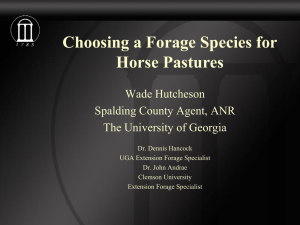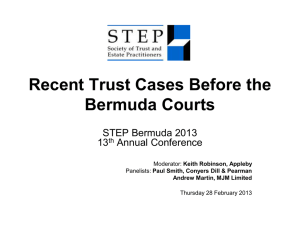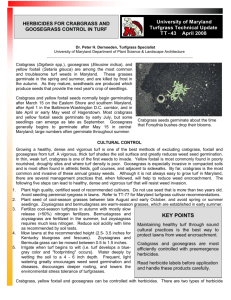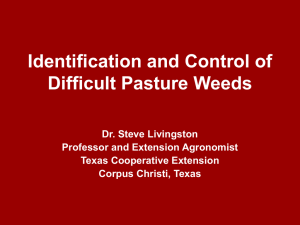Controlling Difficult Weeds in the Landscapes
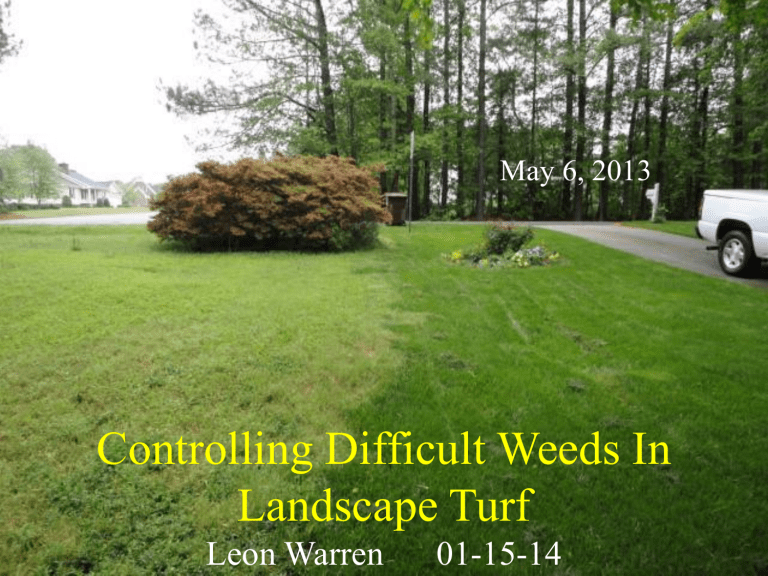
May 6, 2013
Controlling Difficult Weeds In
Landscape Turf
Leon Warren 01-15-14
Why are weeds present in turfgrass?
?
Weeds are the result of improperly managed turf!
What is Properly Managed Turfgrass?
(Four Attributes)
1. Turf species that is adapted to its environment
•Should you choose cool or warm season turf?
In transition zones where both grow pretty well, problems can occur with each species.
Example: Tall fescue doesn’t like 85+ degrees and warm humid conditions (susceptible to diseases).
Bermudagrass can suffer winter kill in harsh winters.
Zone 1: Ky bluegrass, perennial ryegrass, red fescue, tall fescue
Zone 2: Tall fescue, bermudagrass, zoysiagrass
Zone 3: Bermudagrass, centipedegrass, zoysiagrass
Zone 4: St. Augustinegrass, centipedegrass, zoysiagrass
Aug 15, 2007
Mar 20, 2012
Oct 6, 2011
Brown patch and pythium effects
Mar 20, 2012
Bermudagrass winter kill
What is Properly Managed Turfgrass?
2. Turf mowed at proper height and frequency
Fescue and bluegrass mixtures do not survive very well mowing heights shorter than 3 inches, especially during the summer due to heat stress.
Their root systems do not store enough food reserves to promote new shoot production.
Weeds can quickly invade thinned areas.
Effect of Mowing Height on Large Crabgrass
Incidence
3.5lbs Crabgrass/1000ft 2 seeded March 7, 2007
Mowing heights initiated when soil temperatures reached 55°F – mowed every 4 days thereafter
Tall fescue mowed at 1, 2, 3, 4 inches
Bermudagrass mowed at 0.5, 1, 1.5, 2 inches
Effect of Mowing Height on
Crabgrass Incidence in Tall fescue
60
50
40
30
20
10
0
100
90
80
70 a
79
74 a b
31 c
0
4.0" 1.0" 2.0" 3.0"
Mowing Height
Data Collected: 09-13-07, LSD (P=0.05), Sandhills Research Station,
Sodman 90/10 (mixture w/ bluegrass)
4” 3”
2” 1”
Aug 20, 2007
Effect of Mowing Height on Large Crabgrass
Incidence in Common Bermudagrass
60
50
40
30
20
10
0
100
90
80
70
23 a
25 a
18 a
15 a
2.0" 0.5" 1.0" 1.5"
Mowing Height
Data Collected: 09-13-07, LSD (P=0.05), Lake Wheeler Field Lab
0.5”
1.5”
1.0”
2.0”
Bermudagrass Encroachment in Tall Fescue
• Bermudagrass plugs (4.25” diameter) installed – March 31, 2007
•
Mowing initiated 2 days following installation
• 4 plugs per plot (2.5 ft in from each side of plot)
• Grid counts taken bi-weekly
• % area of bermudagrass
• Mowing heights included: 1”, 2”, 3”,
4”, 4” w/out plugs)
Effect of Tall Fescue Mowing Height on
Bermudagrass Encroachment
20
15
10 a
10
5
0
1.0" b
4
2.0" bc
2
3.0"
Mowing Height c
1 c
0
4.0" 4.0" - No
Plugs
Data Collected: 11-10-07, Lake Wheeler Field Lab, Confederate Blend, LSD (P=.05)
3”
2”
4”
What is Properly Managed Turfgrass?
3. Turf that is fertilized at the proper time with the proper rate and technique
What is Properly Managed Turfgrass?
4. Turf site that is well drained, noncompacted and receives adequate rainfall or irrigation
Coastal plain region: sandy to sandy loam soils
(droughty)
Piedmont region: clay to clay loam soils
(compacted)
Five Weed Control Procedures
A successful weed management strategy should integrate all of these procedures and not rely heavily on one.
Preventative
Mechanical
Biological
Cultural
Chemical
Weed Control Procedures
Cultural
The best way to prevent weed problems in turf is to properly manage the turfgrass.
•Select an adapted grass species
•Mow at proper height and frequency
•Fertilize at proper time and rates
•Irrigate as needed in morning, not late evening
•Improve soil drainage by adding soil or soil mixes
Weed Control Procedures
Chemical
The quickest, practical way to prevent or control weed problems in turf is to apply herbicides.
Herbicides are short-term solutions . Results can be seen quickly, and people are happy. Herbicides do not correct the problem as to why weeds were present in the first place. As long as the problems are not corrected, the need for herbicides will exist.
JANUARY - MARCH
Weed Management Options
POST Weed Management Strategies
Annual bluegrass: our most common and troublesome cool season grass weed problem
Cool season broadleaf weeds (many annuals and perennials)
Henbit, chickweed, dandelion, clover, cudweed, woodsorrel
Wild garlic
PRE Weed Management Strategies
Crabgrass and goosegrass
Perennial and Winter Annual Broadleaf Weeds:
Poa annua
• metribuzin (Sencor 75 Turf) 0.67 lb/acre
• glyphosate
(Roundup Pro, Touchdown Pro) 1 pt/acre*
• flumioxazin (SureGuard) 8 to 12 oz/acre*
*0.25 - 0.5% v/v nonionic surfactant
Dormant nonoverseeded bermuda only!
Photo Nov 17, 2011
6 to 10 oz/acre SureGuard 2 WAT
POAAN Control Using Sureguard 51WG and
Monument 75WG in Tifsport Bermudagrass
19 lsd p=.05
100
2-Nov 1-Dec
80
60
40
20
0
Sure
6 oz
Sure
12 oz
Mon
0.45 oz
Check
2010-11: Lake Wheeler Field Lab
4-Jan
7-Mar
Rated Apr 21
7-Feb
6-Apr
Dec Jan
12 oz/A Sureguard (Images Apr 21, 2011)
Feb Check
Poa annua Control and Seedhead
Suppression in Overseeded Bermuda
Herbicide: Amicarbazone (Xonerate)
Xonerate is tolerant to many established (at least 6 months) cool and warm season turf species, BUT its main niche is bermudagrass overseeded with perennial ryegrass.
Cool season: 2 to 4 oz/acre at 2 to 3 wk intervals
Warm season: 3 to 10 oz/acre at 2 to 3 wk intervals
Annual Bluegrass Control in Triple Threat
Ryegrass Using Amicarb at 2 and 4 oz/A
6 22 22 lsd p=.05
100
Amicarbazone 2 oz/A
Feb 23 and Mar 7
80
Amicarbazone 4 oz/A
Feb 23 and Mar 7
60
Amicarbazone 2 oz/A
Feb 23 and Mar 15 40
20
Amicarbazone 4 oz/A
Feb 23 and Mar 15
0
21-Mar 6-Apr 21-Apr
2010-11: Lake Wheeler Field Lab
Check
Induce applied at 0.25%
Xonerate - 2 oz/acre
Feb 23 and Mar 7
Overseeded Oct 13
Lake Wheeler
Check (Apr 21)
Xonerate - 4 oz/acre
Feb 23 and Mar 7
Overseeded Oct 13
Lake Wheeler
Check (Apr 21)
Photo Mar 1, 2012
Xonerate applied TOO SOON (Dec 8, 2011 to Feb 15, 2012)
3 to 4 oz/acre per application (twice)
Ryegrass overseeded Oct 10, 2011
Apply Xonerate starting late Feb to early Mar, not in the fall , or ryegrass stand will be wiped out!!!!!
Poa annua and Winter Annual Broadleaf
Weed Control in Nonoverseeded Turf
Sulfonlyurea Herbicides
***Certainty 75WG (erratic control)
Katana 25DG (excellent)
Monument 75WG (excellent)
Revolver 0.19SC (excellent)
TranXit GTA 25DF (excellent)
Apply to bermuda and zoysia when poa growth resumes but before poa seedhead formation (Mar).
Revolver
1.09 pt/A
Applied Nov
Photo Apr
Monument + NIS
0.56 oz/A + 0.25%
Applied Nov
Photo Apr
Tranxit + NIS
1 oz/A + 0.25%
Applied Nov
Photo Apr
Katana + NIS
3 oz/A + 0.25%
Applied Nov
Photo Apr
Winter Annual Broadleaf Weeds
Henbit
Chickweed species
Carolina geranium
Speedwell species
Lawn burweed
Field pansy
Hairy bittercress
Hop clover
Parsley-piert
Buttercup
Field pansy
Purple deadnettle
Swinecress
Facelis (trampweed)
Vetch species
Knawel
Shepherds-purse
Pepperweed
Cool Season Perennial Broadleaf Weeds
Dandelion species
White clover
Plantain species
Cudweed species
Mock strawberry
Florida betony
Mallow species
Wild violet
Postemergence Broadleaf Weed
Control in Tall Fescue
- Fall timings ideal if fescue is established, especially for henbit control
- Henbit is often extremely difficult to control with winter or spring applications
Postemergence Henbit Control in Common
Bermudagrass with Standard Herbicides
100
80
60
40
20
0
35 LSD (p=.05)
13
25
34
40
52
73
27
21
99
Amine 4 3.74SL
2 pt/A
Spotlight 1.5EC
1.33 pt/A
Amine 4 + Spotlight
0.67 + 1 pt/A
Confront 3SL
1.5 pt/A
Millenium Ultra 3.75L
2.5 pt/A
Speed Zone 2.2EC
3.5 pt/A
Trimec Classic 3.32L
3.5 pt/A
Trimec Southern
4.58SL 2 pt/A
Manor 60WG + X-77
0.5 oz/A + 0.25%
Check
Sprayed Mar 14, 2005 Rated Apr 11, 2005 (Sampson County)
Trimec Classic 3.5 pt/A: Apr 11, 2005 (4 WAT)
Henbit control
averaged over 1997 - 2007
100
80
60
50
Millenium Ultra 2 1-1.25 qt
Escalade 2 1-1.5 qt
Trimec Classic 1.5-1.75 qt
Confront 1-2 pt
Coolpower 1-1.5 qt
39 38
43 42
40
20
0
Rates are product per acre, averaged across formulations, locations, years.
Check
Escalade 2 4EC 3 pt/A
Applied 10-22-09
Photo 11-17-09
Postemergence Broadleaf Weed Herbicides
Labeled for Cool or Warm Season Turf Use
2,4-D
Weedar 64
Mecoprop Dicamba
MCPP-p 4 Amine Banvel, Vanquish
Three-way mixes: Triplet SF, Three-Way Selective
Trimec – many formulations (southern)
MCPA and / or triclopyr-containing products
Tri-Power, Cool Power, Horsepower, Battleship III, Chaser
Clopyralid-containing products (legumes) (not for home use)
Lontrel, Confront, Millennium Ultra, Millennium Ultra 2
Postemergence Broadleaf Weed Herbicides
Labeled for Cool or Warm Season Turf Use
Carfentrazone-containing products (quicker burndown)
Power Zone, Speed Zone, Speed Zone Southern , SquareOne,
Quicksilver
Fluroxypyr-containing products (woody plants-buttonweed)
Escalade, Escalade Low Odor, Escalade 2, Battleship III
Florasulam-containing products
Defendor
Postemergence Broadleaf Weed Herbicides
Labeled for Cool or Warm Season Turf Use
Penoxsulam-containing products
Lockup formulations
Sulfentrazone-containing products (quicker burndown)
Blindside, Dismiss, Solitare, Surge, Tzone
Q4 – dormant bermuda; Q4 Plus – actively growing bermuda
Pyraflufen-containing products (even quicker burndown!!!)
Octane, 4-Speed, 4-Speed XT
Mar 20, 2012
Winter Broadleaf Weed Control in bermuda
Postemergence Broadleaf Weed
Control in Bermudagrass
- Henbit easily controlled with sulfonylureas in fall, winter or spring; however – fall timings still ideal
Certainty – 1.25 oz/A
Manor – 0.25 to 0.5 oz/A
Monument – 0.33 to 0.56 oz/A
Revolver – 1.09 pt/A
TranXit – 1 oz/A
Postemergence Broadleaf Weed Herbicides
Labeled for Warm Season Turf Use Only
Metsulfuron (Manor, MSM, Blade) -fine fescue, Ky bluegrass
Sulfentrazone + imazethapyr (Dismiss South)
Bayer CropScience
Thiencarbazone + iodosulfuron + dicamba
Celsius 68WG (registered in 2010)
Thiencarbazone + foramsulfuron + halosulfuron
Tribute Total 60.5WG (registered in 2012)
Use on bermuda, zoysia, centipede and St. Augustinegrass in golf, sod farm, residential, commercial, sport and roadside turf areas
2.5 oz/A applied 3X at 3 wk intervals as needed
3.7 oz/A applied 2X at 3 wk intervals as needed
4.9 oz/A fb 2.5 oz/A at 3 wk intervals as needed
Add a non-ionic surfactant or methylated seed oil
Turf tolerances: bermuda, zoysia
Turf uses: golf, sod production, residential and commercial properties, sports facilities, roadsides
1 to 2 oz/A controls annual bluegrass, ryegrass, tall fescue, species of chickweed, clover, cudweed, dandelion, henbit, hairy bittercress, knawel, buckhorn plantain, corn speedwell
3.2 oz/A controls geranium, parsley-piert, yellow woodsorrel
Add a non-ionic surfactant or methylated seed oil
Wild Garlic
2,4-D amine
3 qt/acre + surfactant
Tall fescue, perennial ryegrass,
Kentucky bluegrass
Bermudagrass, zoysiagrass
Treat for 2 years
Treat Oct-Nov or Feb-Mar
Mar 11, 2005 (17 DAT)
Wild Garlic – Warm Season Turf
Manor** = slightly sensitive
0.33 to 0.5 oz/acre + surfactant
Bermuda, centipede**, zoysia, St. Augustine, Ky. bluegrass
Corsair** = slightly sensitive
2.76 to 5.33 oz/acre + surfactant
Bermuda, centipede**, zoysia**, St. Augustine**, Ky. bluegrass
Image 70DG
0.35 to 0.7 lb/acre + surfactant
Bermuda, centipede, zoysia before spring greenup
Check
Centipede
Corsair + NIS
4 oz/acre + 0.25%
Applied Nov 2010
Photo Mar 19, 2011
Pre Crabgrass and Goosegrass Control in Fescue and Bermuda
Apply now through early March before germination
1. Usually advantageous to split applications at 6 to 8 wk intervals if using DNA herbicides (benefin, oryzalin, prodiamine, pendimethalin) or dithiopyr
2. If fall seeded, prodiamine may be safest on immature fescue roots
Smooth Crabgrass Control in Tall Fescue
31 LSD ( P = .05)
100
80
60
40
20
0
Single - Full Rate Split - Half Rate 2X
09-02-03 (175 DAIT) Trt Dates: Mar 11 and May 9
Barricade 65WG [3]
Barricade 4F [3]
Dimension 1EC [4]
Dimen. Ultra 40WP [4]
Pre-M 60DF [3]
Pendulum 3.3EC [3]
Pend. Aqua Cap [3]
Pendulum 2G [3]
Surflan 4F [3]
Team Pro 0.86G [3+3]
Check
Application Effects on Smooth Crabgrass
2002 – 2007: Wesleyan College – Rocky Mt.
100
85
77
80
One Application
60 b a
40
Two Applications
20
0
September
PRE Crabgrass and Goosegrass Control in Fescue and Bermuda
Dinitroaniline (DNA) herbicides and Dimension
Even tolerant turfgrasses display root stubbing or root clubbing symptoms. Do not use this family of herbicides on athletic fields because of this.
Roots can be sheared off due to heavy traffic and death can occur.
Photo Taken
10-29-01
St. Augustinegrass
Nontreated
St. Augustinegrass
Barricade 65WG
Spring, 2001
Clubbed roots
PRE Grass Herbicides on Fall Established Turf
Balan, Surflan, Team Pro labels advise against applications until 1 growing season has passed.
Pendulum Aquacap can be applied after new turf has filled in and been mowed at least 4 times .
Barricade can be applied after new turf has filled in and been mowed at least 2 times or 60 days after overseeding.
Dimension can be applied after new turf has filled in and been mowed at least 2 times .
Tolerance of fall-seeded tall fescue to PRE herbicides with single applications
100 Barricade 0.75 lb
Dimension 0.5 lb
80
64
Pendulum 3 lb
60
49
Ronstar 3 lb
46
40
30
Team 3 lb
14
23 24
20
4
19
3
10 10
15
3
10
0 seeded Oct 10
LSD=15.7
seeded Oct 16
LSD=16.5
seeded Oct 30
LSD=21.3
Barricade - 65WG, Dimension - 1EC, Pendulum - 3.3EC, Ronstar - 2G, Team - 2G.
Treatments applied March 11, 1996. Evaluations taken May 27.
Tolerance of fall-seeded tall fescue to PRE herbicides with split applications
100
80
60
40
20
25
20 19
23
20
1
21
30
8
16
Barricade 0.5 fb 0.25 lb
Dimension 0.25 fb 0.25 lb
Pendulum 1.5 fb 1.5 lb
Ronstar 2 fb 1 lb
Team 1.5 fb 1.5 lb
1
5
0
6
0
0 seeded Oct 10
LSD=15.7
seeded Oct 16
LSD=16.5
seeded Oct 30
LSD=21.3
Barricade - 65WG, Dimension - 1EC, Pendulum - 3.3EC, Ronstar - 2G, Team - 2G.
Initial trts applied March 11, 1996; sequentials applied May 6. Evaluations on May 27.
PRE Weed Management Strategies
Herbicide family: Oxadiazole
Oxadiazon (Ronstar G, 50WSP, 3.17SC)
Absorbed by shoots only, inhibits photosynthesis
Does not inhibit root growth
Therefore, use this product in worn turf or where additional grow-in is desired ( athletic fields )
Not labeled for home use!!!
PRE Crab and Goose Control in Bermuda
Specticle 20WSP or 0.622F – overseeding concerns
Specticle rate (oz/A)
2.5
3.75
Overseeding Interval
8 months
12 months
Specticle rate (fl oz/A) Overseeding Interval
4.5 to 6 10 months
6 to 9 12 months

